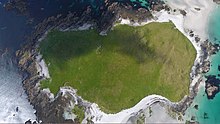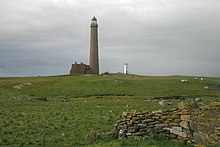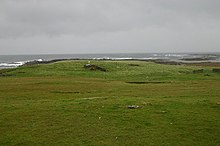Monach Islands
| Monach Isles SSSI | |
|---|---|
IUCN categoryIV (habitat/species management area) | |
 Ceann Iar,the most westerly of the three main Monach Islands | |
 Location of the Monach Islands | |
| Location | Outer Hebrides,Scotland |
| Coordinates | 57°31′N7°40′W/ 57.517°N 7.667°W |
| Area | 598.1 ha (1,478 acres)[1] |
| Governing body | NatureScot |
TheMonach Islands,also known asHeisker(Scottish Gaelic:Eilean Heisgeir/Heisgeir,pronounced[(elan)ˈheʃkʲəɾʲ]), are anisland groupwest ofNorth Uistin theOuter HebridesofScotland.The islands are not to be confused withHyskeirin theInner Hebrides,orHaskeirwhich is also off North Uist and visible from the group.
Geology and geography
[edit]
The main islands ofCeann Ear(once home to anunnery),Ceann IarandShivinish(Sibhinis) are all linked atlow tide.It has been claimed that it was at one time possible to walk all the way toBaleshare,and on toNorth Uist,five miles away at low tide. In the 17th century, a large tidal wave is said to have washed this route away.[2]The islands of the group tend to be low-lying and sandy, subject to intensecoastal erosion.Not unlike theIsles of Scillyit is possible thatCeann Iar,Shivinish andCeann Earformed a single body of land within historic times, and that their land area has greatly decreased due to overgrazing, sea inundation, and wind erosion.
Smaller islands in the group include Deasker (Deas-Sgeir),Shillay(Siolaigh) andStocaigh(or Stockay).
History
[edit]

The islands have been uninhabited since 1942, but were populated by up to 100 people for centuries (possibly for a millennium or more) prior to 1810. They were originally abandoned due toovergrazing,but were resettled by 1841 in the wake of theHighland Clearances.[2][3]
The 19th century census records for the islands show a fluctuating population, from 39 people in 1841 up to 140 people at their peak population in 1891.[4][5]
Shillayis the location of Monach Lighthouse, built byDavidandThomas Stevensonin 1864. The lighthouse was closed in 1942 but, following the sinking of the oil tankerMVBraerin 1993, a new and much smaller lighthouse was built in 1997. This had a range of 10 nautical miles (19 kilometres); when a range of 18 nautical miles (33 kilometres) was deemed necessary, the new lighthouse was shut down in 2008 and the old lighthouse recommissioned with a new optic. Like all British lighthouses it is now unmanned and fully automated.[6]
In 2007 renovations of the old schoolhouse were completed, enabling visitors to stay on the island, and learn about its history and wildlife. The old Heisgeir mailboat has also been restored at theGrimsayboatshed. The 28 ft (8.5 m) motorised open wooden boat was built circa 1932 for the last family to leave the Monach Islands, and had lain unused atLochmaddybefore being rescued by the local history society.[7]
Lady Grange
[edit]JacobitesympathiserJames Erskine, Lord Grange(1679–1754), had his wifeRachelkidnapped and abandoned on the Monach Isles between 1732 and 1734. At the time the islands were owned by Sir Alexander MacDonald ofSleatand she was housed with his tacksman (leaseholder), another Alexander MacDonald and his wife. When Lady Grange complained about her condition, she was told by her host that he had no orders to provide her either with clothes, or food other than the normal fare he and his wife were used to. She lived in isolation, not even being told the name of the island where she was living, and it took her some time to find out who her landlord was. She was there until June 1734 when John and Norman MacLeod from North Uist arrived to move her on. They told her they were taking her toOrkney,[8][9]but she was taken toHirtawhere she lived from 1734 to 1742 before being taken toSkyewhere she died after a failed rescue attempt.[10][11]
Wildlife and conservation
[edit]
The islands are of special interest for undisturbedmachairand theirgrey sealpopulation. About 10,000 seals come ashore each autumn to have their pups and mate, making it one of the largest such colonies in the world.[12]There are also a large number of nestingseabirdsand a richflora.Grey heronsnest in some of the abandoned buildings.[13]There are no trees on the islands.[citation needed]
The islands are designated as aSpecial Protection Area(SPA), aSpecial Area of Conservation(SAC), and aSite of Special Scientific Interest(SSSI).[14][1][15]TheInternational Union for Conservation of Nature(IUCN) classifies as the islands (via the SSSI designation) as meeting the criteria for aCategory IVprotected area.[16]The SAC designation extends to cover the seas surrounding the group,[15]and in 2014 a larger area of the sea surrounding the islands (in total 6,200 hectares or 18 square nautical miles) was declared aNature Conservation Marine Protected Area(NCMPA). The designation is in place to protect the feeding grounds of the islands' seabirds, as well as the marinegeomorphologyof the seabed.[17]The Monach Islands were also formerly designated as anational nature reserve,[18]however this designation was withdrawn in May 2018.[19]
See also
[edit]References
[edit]- ^ab"Monach Isles SSSI".NatureScot.Retrieved11 October2020.
- ^abHaswell-Smith, Hamish (2004).The Scottish Islands.Edinburgh: Canongate.ISBN978-1-84195-454-7.
- ^"Notes on the early history of Heisker or the Monach Isles".Monach Islands, Heisker.Retrieved15 April2020.
- ^"1841-1871 Census Records, Monach Islands, Heisker".Monach Islands, Heisker.Retrieved15 April2020.
- ^"1881-1911 Census Records, Monach Islands, Heisker".Monach Islands, Heisker.Retrieved15 April2020.
- ^"Monach Lighthouse".Northern Lighthouse Board.Archived fromthe originalon 7 August 2009.Retrieved8 December2007.
- ^Ross, John (7 April 2007). "Renovation breathes new life into windswept Monach Isles".The Scotsman.Edinburgh.
- ^Macauley (2009) pp. 84–86
- ^Haswell-Smith (2004) pp. 254–56
- ^Quine, David (2000).Island Guides: St. Kilda.Grantown-on-Spey: Colin Baxter.
- ^Steel, Tom (1988).The Life and Death of St. Kilda.London: Fontana.
- ^"Monach Islands".Western Isles Guide Book. Archived fromthe originalon 9 October 2006.Retrieved8 December2007.
- ^Murray, W.H.(1966)The Hebrides.London. Heinemann. Page 205.
- ^"Monach Islands SPA".NatureScot.Retrieved11 October2020.
- ^ab"Monach Islands SAC".NatureScot.Retrieved11 October2020.
- ^"Monach Isles".Protected Planet.Retrieved11 October2020.
- ^"Monach Isles MPA(NC)".NatureScot.Retrieved11 October2019.
- ^"Monach Islands".Archived fromthe originalon 10 October 2007.Retrieved8 December2007.
- ^"Protected area notices".Scottish Natural Heritage. 18 May 2018.Retrieved1 June2018.
- IUCN Category IV
- Monach Islands
- Uninhabited islands of the Outer Hebrides
- Former populated places in Scotland
- Sites of Special Scientific Interest in Western Isles South
- Special Areas of Conservation in Scotland
- Important Bird Areas of Scotland
- Protected areas of the Outer Hebrides
- Nature Conservation Marine Protected Areas of Scotland
- Archipelagoes of Scotland
